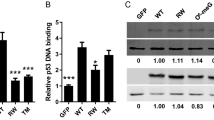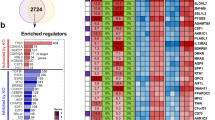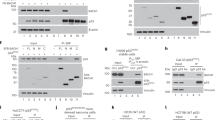Abstract
Since the very early days of p53 research, the gain of oncogenic activities by some mutant p53 proteins had been suspected as an important factor contributing to cancer progression. Considerable progress towards understanding the biology of mutant p53 has been made during the last years, the quintessence being the realization that the impact of mutant p53 proteins on the transcriptome of a tumor cell is much more global than previously thought. The emerging role of mutant p53 proteins in coordinating oncogenic signaling and chromatin modifying activities reveals an until now unsuspected function of these proteins as important modifiers of the oncogenic transcriptional response. Notwithstanding the fact that the sequence-specific DNA binding activity of mutant p53 proteins is impaired, they are still able to associate with specific loci on DNA by utilizing different mechanisms. The ability to associate with DNA appears to be crucial for the master role of mutant p53 proteins in coordinating oncogenic transcriptional responses.
This is a preview of subscription content, access via your institution
Access options
Subscribe to this journal
Receive 50 print issues and online access
$259.00 per year
only $5.18 per issue
Buy this article
- Purchase on Springer Link
- Instant access to full article PDF
Prices may be subject to local taxes which are calculated during checkout
Similar content being viewed by others
References
Ahn J, Prives C . (2001). The C-terminus of p53: the more you learn the less you know. Nat Struct Biol 8: 730–732.
Ang HC, Joerger AC, Mayer S, Fersht AR . (2006). Effects of common cancer mutations on stability and DNA binding of full-length p53 compared with isolated core domains. J Biol Chem 281: 21934–21941.
Bae BI, Xu H, Igarashi S, Fujimuro M, Agrawal N, Taya Y et al. (2005). p53 mediates cellular dysfunction and behavioral abnormalities in Huntington's disease. Neuron 47: 29–41.
Campomenosi P, Monti P, Aprile A, Abbondandolo A, Frebourg T, Gold B et al. (2001). p53 mutants can often transactivate promoters containing a p21 but not Bax or PIG3 responsive elements. Oncogene 20: 3573–3579.
Chicas A, Molina P, Bargonetti J . (2000). Mutant p53 forms a complex with Sp1 on HIV-LTR DNA. Biochem Biophys Res Commun 279: 383–390.
Cho Y, Gorina S, Jeffrey PD, Pavletich NP . (1994). Crystal structure of a p53 tumor suppressor-DNA complex: Understanding tumorigenic mutations. Science 265: 346–355.
Di Agostino S, Strano S, Emiliozzi V, Zerbini V, Mottolese M, Sacchi A et al. (2006). Gain of function of mutant p53: the mutant p53/NF-Y protein complex reveals an aberrant transcriptional mechanism of cell cycle regulation. Cancer Cell 10: 191–202.
El-Deiry WS, Kern SE, Pietenpol JA, Kinzler KW, Vogelstein B . (1992). Definition of a consensus binding site for p53. Nat Genet 1: 45–49.
Feng Z, Jin S, Zupnick A, Hoh J, de Stanchina E, Lowe S et al. (2006). p53 tumor suppressor protein regulates the levels of huntingtin gene expression. Oncogene 25: 1–7.
Frazier MW, He XP, Wang JL, Gu ZM, Cleveland JL, Zambetti GP . (1998). Activation of c-myc gene expression by tumor-derived p53 mutants requires a discrete C-terminal domain. Mol Cell Biol 18: 3735–3743.
Gilliland DG . (2001). The diverse role of the ETS family of transcription factors in cancer. Clin Cancer Res 7: 451–453.
Göhler T, Jager S, Warnecke G, Yasuda H, Kim E, Deppert W . (2005). Mutant p53 proteins bind DNA in a DNA structure-selective mode. Nucleic Acids Res 33: 1087–1100.
Göhler T, Reimann M, Cherny D, Walter K, Warnecke G, Kim E et al. (2002). Specific interaction of p53 with target binding sites is determined by DNA conformation and is regulated by the C-terminal domain. J Biol Chem 277: 41192–41203.
Gu L, Zhu N, Findley HW, Woods WG, Zhou M . (2004). Identification and characterization of the IKKalpha promoter: positive and negative regulation by ETS-1 and p53, respectively. J Biol Chem 279: 52141–52149.
Gu Z, Kuntz-Simon G, Rommelaere J, Cornelis J . (1999). Oncogenic transformation-dependent expression of a transcription factor NF-Y subunit. Mol Carcinog 24: 294–299.
Gualberto A, Hixon ML, Finco TS, Perkins ND, Nabel GJ, Baldwin Jr AS . (1995). A proliferative p53-responsive element mediates tumor necrosis factor alpha induction of the human immunodeficiency virus type 1 long terminal repeat. Mol Cell Biol 15: 3450–3459.
Hupp TR, Lane DP . (1994). Regulation of the cryptic sequence-specific DNA-binding function of p53 by protein kinases. Cold Spring Harbor Symp Quant Biol 59: 195–206.
Imbriano C, Gurtner A, Cocchiarella F, Di Agostino S, Basile V, Gostissa M et al. (2005). Direct p53 transcriptional repression: in vivo analysis of CCAAT-containing G2/M promoters. Mol Cell Biol 25: 3737–3751.
Inga A, Monti P, Fronza G, Darden T, Resnick MA . (2001). p53 mutants exhibiting enhanced transcriptional activation and altered promoter selectivity are revealed using a sensitive, yeast-based functional assay. Oncogene 20: 501–513.
Joerger AC, Fersht AR . (2007). Structure – function – rescue: the diverse nature of common p53 cancer mutants. Oncogene doi:10.1038/sj.onc.1210312.
Joerger AC, Ang HC, Fersht AR . (2006). Structural basis for understanding oncogenic p53 mutations and designing rescue drugs. Proc Natl Acad Sci USA 103: 15056–15061.
Kim E, Deppert W . (2003). The complex interactions of p53 with target DNA: we learn as we go. Biochem Cell Biol 81: 141–150.
Kim E, Deppert W . (2004). Transcriptional activities of mutant p53: when mutations are more than a loss. J Cell Biochem 93: 878–886.
Kim E, Gunther W, Yoshizato K, Meissner H, Zapf S, Nusing RM et al. (2003). Tumor suppressor p53 inhibits transcriptional activation of invasion gene thromboxane synthase mediated by the proto-oncogenic factor ets-1. Oncogene 22: 7716–7727.
Koga H, Deppert W . (2000). Identification of genomic dna sequences bound by mutant p53 protein (Gly245->Ser) in vivo. Oncogene 19: 4178–4183.
Koutsodontis G, Vasilaki E, Chou WC, Papakosta P, Kardassis D . (2005). Physical and functional interactions between members of the tumour suppressor p53 and the Sp families of transcription factors: importance for the regulation of genes involved in cell-cycle arrest and apoptosis. Biochem J 389: 443–455.
Lachner M, O'Carroll D, Rea S, Mechtler K, Jenuwein T . (2001). Methylation of histone H3 lysine 9 creates a binding site for HP1 proteins. Nature 410: 116–120.
Menendez D, Inga A, Jordan A, Resnick MA . (2007). Changing the p53 master regulatory network: ELEMENTary, my dear Mr.Watson. Oncogene (this issue).
Müller BF, Paulsen D, Deppert W . (1996). Specific binding of MAR/SAR DNA-elements by mutant p53. Oncogene 12: 1941–1952.
Nguyen TT, Cho K, Stratton SA, Barton MC . (2005). Transcription factor interactions and chromatin modifications associated with p53-mediated, developmental repression of the alpha-fetoprotein gene. Mol Cell Biol 25: 2147–2157.
Oikawa T . (2004). ETS transcription factors: possible targets for cancer therapy. Cancer Sci 95: 626–633.
Okorokov AL, Sherman MB, Plisson C, Grinkevich V, Sigmundsson K, Selivanova G et al. (2006). The structure of p53 tumour suppressor protein reveals the basis for its functional plasticity. EMBO J 25: 5191–5200.
Pang JH, Good LF, Chen KY . (1996). The age-dependent binding of CBP/tk, a CCAAT binding protein, is deregulated in transformed and immortalized mammalian cells but absent in premature aging cells. Exp Gerontol 31: 97–109.
Pastorcic M, Das HK . (2000). Regulation of transcription of the human presenilin-1 gene by ets transcription factors and the p53 protooncogene. J Biol Chem 275: 34938–34945.
Sampath J, Sun DX, Kidd VJ, Grenet J, Gandhi A, Shapiro LH et al. (2001). Mutant p53 cooperates with ETS and selectively up-regulates human MDR1 not MRP1. J Biol Chem 276: 39359–39367.
Saveliev A, Everett C, Sharpe T, Webster Z, Festenstein R . (2003). DNA triplet repeats mediate heterochromatin-protein-1-sensitive variegated gene silencing. Nature 422: 909–913.
Scian MJ, Stagliano KE, Anderson MA, Hassan S, Bowman M, Miles MF et al. (2005). Tumor-derived p53 mutants induce NF-kappaB2 gene expression. Mol Cell Biol 25: 10097–10110.
Scian MJ, Stagliano KE, Ellis MA, Hassan S, Bowman M, Miles MF et al. (2004). Modulation of gene expression by tumor-derived p53 mutants. Cancer Res 64: 7447–7454.
Selivanova G, Iotsova V, Okan I, Fritsche M, Stroem M, Groner B et al. (1997). Restoration of the growth suppression function of mutant p53 by a synthetic peptide derived from the p53 C-terminal domain. Nature Med 3: 632–638.
Sigal A, Rotter V . (2000). Oncogenic mutations of the p53 tumor suppressor: The demons of the guardian of the genome. Cancer Res 60: 6788–6793.
Sinden RR, Potaman VN, Oussatcheva EA, Pearson CE, Lyubchenko YL, Shlyakhtenko LS . (2002). Triplet repeat DNA structures and human genetic disease: dynamic mutations from dynamic DNA. J Biosci 27: 53–65.
Stenger EJ, Tegtmeyer P, Mayr GA, Reed M, Wang Y, Wang P et al. (1994). p53 oligomerization and DNA looping are linked with transcriptional activation. EMBO J 13: 6011–6020.
Strano S, Dell'Orso S, DiAgostino S, Fontemaggi G, Sacchi A, Blandino G . (2007). Mutant p53: an oncogenic transcription factor. Oncogene (this issue).
Tsutsumi-Ishii Y, Tadokoro K, Hanaoka F, Tsuchida N . (1995). Response of heat shock element within the human HSP70 promoter to mutated p53 genes. Cell Growth Differ 6: 1–8.
Walter K, Warnecke G, Bowater R, Deppert W, Kim EL . (2005). Tumor suppressor p53 binds with high affinity to CTG-CAG trinucleotide repeats and induces topological alterations in mismatched duplexes. J Biol Chem 280: 42497–42507.
Wang YH, Griffith J . (1995). Expanded CTG triplet blocks from the myotonic dystrophy gene create the strongest known natural nucleosome positioning elements. Genomics 25: 570–573.
Weißker S, Müller B, Homfeld A, Deppert W . (1992). Specific and complex interactions of murine p53 with DNA. Oncogene 7: 1921–1932.
Yang X, Pater A, Tang SC . (1999). Cloning and characterization of the human BAG-1 gene promoter: upregulation by tumor-derived p53 mutants. Oncogene 18: 4546–4553.
Zalcenstein A, Stambolsky P, Weisz L, Muller M, Wallach D, Goncharov TM et al. (2003). Mutant p53 gain of function: repression of CD95(Fas/APO-1) gene expression by tumor-associated p53 mutants. Oncogene 22: 5667–5676.
Acknowledgements
We thank Martina Hintz-Malchow for assistance in preparing the manuscript. Research performed in the WD and EK laboratories and cited in this review was supported by the DFG (De 212/19-5), the Fonds der Chemischen Industrie, and by EC FP5 and FP6 funding. The publication reflects only the authors' views and the Community is not liable for any use that may be made of the information contained therein. The Heinrich-Pette-Institut is financially supported by the Freie und Hansesstadt Hamburg and the Bundesministerium für Gesundheit.
Author information
Authors and Affiliations
Corresponding author
Rights and permissions
About this article
Cite this article
Kim, E., Deppert, W. Interactions of mutant p53 with DNA: guilt by association. Oncogene 26, 2185–2190 (2007). https://doi.org/10.1038/sj.onc.1210312
Published:
Issue Date:
DOI: https://doi.org/10.1038/sj.onc.1210312
Keywords
This article is cited by
-
Transition of amyloid/mutant p53 from tumor suppressor to an oncogene and therapeutic approaches to ameliorate metastasis and cancer stemness
Cancer Cell International (2022)
-
Proteomic identification of ERP29 as a key chemoresistant factor activated by the aggregating p53 mutant Arg282Trp
Oncogene (2017)
-
Anti-Apoptotic NF-κB and “Gain of Function” mut p53 in Concert Act Pro-Apoptotic in Response to UVB+IL-1 via Enhanced TNF Production
Journal of Investigative Dermatology (2015)
-
The expanding universe of p53 targets
Nature Reviews Cancer (2009)
-
Interactions of mutant p53 with DNA: guilt by association
Oncogene (2007)



